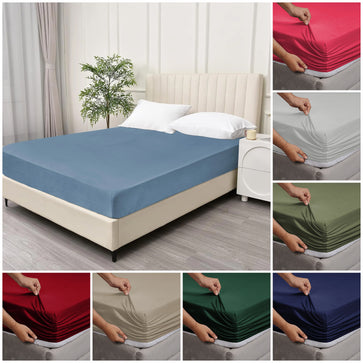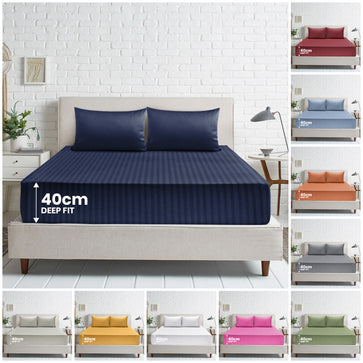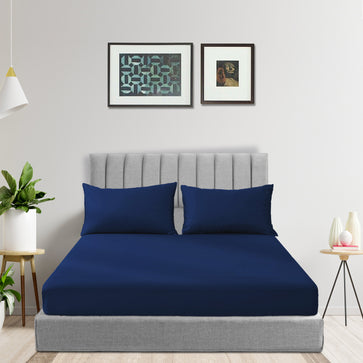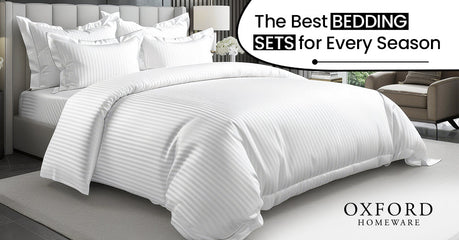How To Keep Fitted Sheets On Bed? DIY Guide




Common Frustrations with Sheets Coming Off
There's nothing more annoying than waking up to find your fitted sheets bunched up at the foot of the bed or, worse, entirely off. Besides the obvious discomfort, constantly fixing the sheets can be time-consuming and disrupt sleep. Understanding the reasons behind this issue is the first step towards finding a solution.
- Constant Disruption: Waking up to find sheets bunched up or entirely off the bed is a recurring annoyance, disrupting sleep and comfort.
- Time-Consuming Adjustments: The need to frequently readjust sheets steals valuable sleeping time, causing frustration and inconvenience.
- Discomfort and Restlessness: Sheets slipping off can lead to pain, causing restlessness and compromised sleep quality.
- Aesthetic Disarray: Besides the practical inconveniences, the visual disarray of a bed with constantly dislodged sheets can be unsightly.
- Potential Health Concerns: Sheets coming off may expose the mattress, increasing the risk of exposure to allergens, dust mites, or other potential health hazards.
- Mismatched Bed Appearance: Using sheets that don't fit the mattress properly can result in an unsuitable and untidy bed appearance.
- Repeated Sheet Replacement: Frequent slippage may lead to increased wear and tear on sheets, necessitating more frequent replacements and added expenses.
- Sleep Interruptions: The frustration of waking up in the middle of the night to fix sheets interrupts the sleep cycle, impacting overall sleep quality and well-being.
Factors Contributing to Sheets Slipping Off

Mattress Type and Size
The type and size of your mattress play a crucial role in how well your sheets stay put. Different mattresses like memory foam or pillow-tops may have unique sheet grip characteristics. Additionally, using sheets that don't match the mattress size can lead to a poor fit, making it easier for them to slip off.
Sheet Material and Elastic Quality
The quality of your sheets, particularly the elastic, is a significant factor. Over time, elastic can wear out, losing its stretch and grip. Cheaper sheets may come with inferior elastic, contributing to the sheets slipping off more frequently.
Assessing Your Sheets
A. Checking Elastic Wear and Tear
Examine the edges to determine if your fitted sheets' elastic is still effective. It might be time for a replacement if you notice fraying, loss of elasticity, or visible wear and tear. Quality sheets with durable elastic are an investment in a comfortable and hassle-free sleep environment.
B. Choosing the Right Sheet Size for Your Mattress
Ensure that your sheets are the correct size for your mattress. Sheets that are too small will need more space to stay in place, while oversized sheets will have excess fabric that can quickly come undone.
DIY Solutions To Keep Fitted Sheets On Bed
Now that you've identified the issues causing your sheets to slip off let's explore practical do-it-yourself solutions to keep your fitted sheets securely anchored.

Solution 1: Sheet Clips and Fasteners
Sheet clips and fasteners are simple yet effective tools designed to grip the corners of your fitted sheet, preventing them from slipping off during the night. These clips can be easily attached to the corners of the sheet, providing an additional anchor point that helps maintain the sheet's position on the mattress.
Solution 2: Fitted Sheet Straps
Fitted sheet straps are adjustable bands designed to go underneath the mattress, securely holding the sheet. These straps act as a secure anchor, preventing the sheet from shifting and ensuring a snug fit throughout the night. They are easy to install and can be adjusted to fit different mattress sizes.
Solution 3: Enhancing Elasticity
Reviving worn-out elastic is a cost-effective DIY solution to keep your fitted sheets in place. If you notice fraying or loss of elasticity along the edges of your sheets, consider sewing new elastic bands onto the corners. Choose high-quality elastic for better durability, and this simple fix can extend the life of your sheets.
Solution 4: Tucking Techniques
Mastering the art of tucking is a skill that can significantly reduce sheet slippage. Tuck the fitted sheet tightly under the mattress, paying extra attention to the corners. Additionally, folding the excess fabric under the bed can create a snug fit, preventing the sheet from coming undone during the night.
Solution 5: Selecting Sheets Wisely
Investing in high-quality sheets with durable elastic is a proactive way to prevent the sheets from slipping off. Opt for sheets made from materials like Egyptian or high-thread-count cotton, known for their comfort and longevity. Choosing the right size for your mattress is equally essential – sheets that are too small or too large may struggle to stay in place.
Solution 6: Mattress Grippers and Toppers
Consider using mattress grippers or toppers to enhance the friction between the mattress and the fitted sheet. These additional layers provide extra grip, reducing the chances of the sheets slipping off. Mattress grippers are available in various materials, including rubber and silicone, offering a versatile solution to cater to different preferences.
Implementing these DIY solutions can transform your bed into a secure haven, free from the frustration of constantly adjusting your sheets.
But why stop there? Let's explore additional bed-making hacks that complement these solutions and contribute to a consistently well-made and secure bed.
Bed-Making Hacks
A. Sequential Layering for Maximum Stay
When making your bed, adopt a sequential layering approach. Start with a mattress protector, a fitted sheet, a flat sheet, and then your duvet or comforter. This strategic layering enhances comfort and anchors the sheets in place, minimizing movement during the night.
B. Utilizing Weight Distribution
Strategically placing heavier items at the foot of the bed can contribute to keeping the fitted sheet in place. Consider using decorative pillows or a neatly folded blanket to add weight, creating resistance against sheet movement and promoting a consistently well-made bed.
Maintenance Tips
A. Regularly Inspecting Sheet Condition
Make it a habit to inspect your sheets for signs of wear and tear. Regular checks can help you identify issues early on, allowing you to address them before they become significant problems.
B. Washing and Drying Practices for Sheet Longevity
Follow proper care instructions when washing and drying your sheets. Over time, excessive heat can degrade elasticity, so opt for lower temperatures. Avoid fabric softeners, as they can affect the elasticity of the sheets.
Conclusion
A good night's sleep is essential for overall well-being, and constantly adjusting slipping sheets can hinder that experience. By understanding the factors contributing to sheets coming off, assessing your sheets, and implementing practical DIY solutions, you can enjoy a restful night without the annoyance of constantly fixing your bedding.
You may also like to check Why Do You Have So Many Gaps In Your Fitted Sheet.
Investing time and effort into maintaining your sheets, choosing the right solutions for your needs, and incorporating bed-making hacks can transform your sleep environment. With the proper knowledge and tools, you can bid farewell to the frustration of fitted sheets slipping off and welcome uninterrupted, peaceful nights.
FAQs
What causes fitted sheets to come off?
Several factors contribute to fitted sheets slipping off, including the type and size of the mattress, the quality of the sheet material and elastic, and wear and tear on the elastic over time.
How often should sheets be replaced?
Sheets should be replaced when you notice wear and tear on the elastic or fabric. Quality sheets can last several years with proper care, but regular inspections are essential to ensure longevity.
Are there specific sheets for different mattress types?
While there may not be specific sheets for each mattress type, different mattresses may require specific considerations. For example, memory foam mattresses may benefit from sheets with extra elasticity to accommodate their contours.






